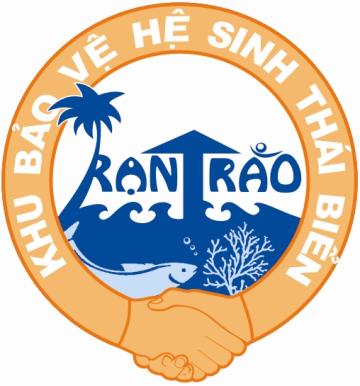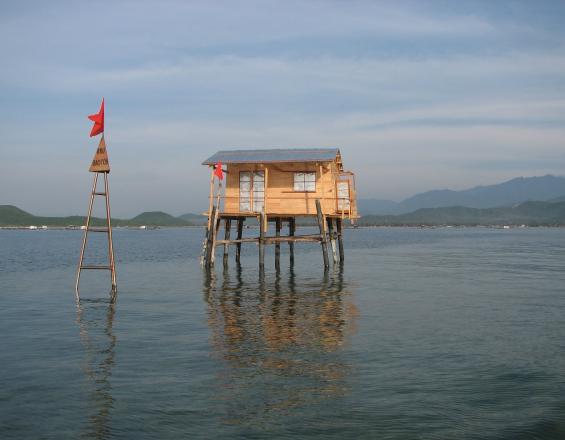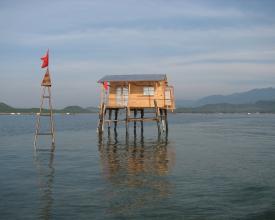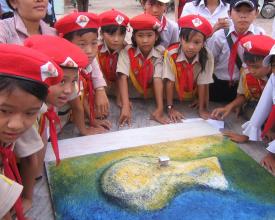
Community-initiated Trao Reef Locally Managed Marine Area
Solución completa

MPA watch station at Trao Reef
MCD
The bottom-up participatory and adaptive Locally Managed Marine Area of Trao reef in Van Hung, Vietnam’s Khanh Hoa province, addresses environmental degradation, resource depletion, weakened management of coral reefs, and climate change adaptation for local fisherfolks. Based on the 2001 community request, the project improved local ownership and management capacities as well as fish stocks.
Last update: 24 Sep 2025
6829 Views
Contexto
Défis à relever
environmental degradation, resource depletion, and weakened management of coral reefs
The Trao Reef faces destruction as already observed at neighboring reefs due to unsustainable fishing, pollution caused by lobster and black tiger shrimp aquaculture, and climate change effects. The open access system, lack of a national legal framework and coordination renders responsibility and accountability of stakeholders ineffective. Thus, the livelihood of most households is at stake.
Ubicación
Van Hung, Khanh Hoa, Vietnam
Southeast Asia
Procesar
Summary of the process
Trao Reef LMMA was developed and implemented through a circular process consisting of four building blocks. The inception phase, the requirements assessment for LMMA (Building block 1) requires a local initiative from the community. With Building block 2 starts implementation of the LMMA with establishment of participative management, the empowerment process of the community coming first. To achieve restoration of a severely degraded reef ecosystem, Building block 3 is implemented. The process of participative adaptive management, including management plan, enforcement of regulations, formal legalisation and monitoring of ecological restoration is constantly fine-tuned (Building block 4). Building blocks 3, 4 and 5 are part of a circular process that takes into account lessons learned and experiences made. The legal framework and continuous support of district and provincial authorities, NGO engagement, science and research are key factors for the successful accomplishment of all 4 building blocks, and the solution.
Building Blocks
Participatory needs assessment
Communities and stakeholders participate in all aspects of the management process, including biological and Participatory Rural Appraisal surveys for baseline data collection and sharing. Together with community groups, stakeholder consultation on locally managed marine area (LMMA) zoning and later management operations are conducted. The results and thus the identified area to be protected are displayed using a 3D model. These activities are accompanied by awareness raising activities about coastal resource protection as well as co-management requirements.
Enabling factors
• Awareness of the local community leading to a request for addressing ongoing problems and challenges
• Small size of the area to be governed under LMMA to allow successful co-design and later co-management
Lesson learned
The local proposal for the Trao Reef LMMA initiative was effective for launching this LMMA project. The consequent capacity building, including awareness rising, for community empowerment are an important precondition to successful LMMA planning and establishment.
Participative management
Adopt co-management structure for locally managed marine area (LMMA) management and monitoring. Regulation of the LMMA is enforced by joint patrols comprising a core group of community members and functional forces. Ownership of the LMMA is transferred to local governance. All outputs of the LMMA are handed over to local authority. Establish the legal status of local stakeholders in the co-management structure. State funding allocates annual budgets to support LMMA implementation.
Enabling factors
• Support from local authority legally governing the LMMA area for mobilising participation of other state and non-state actors
• Active support and commitment of the community
• Involvement of a non-governmental organisation as catalyst to maintain momentum and facilitation, support of stakeholders and seeking funding
• Involvement of scientists and researchers to ensure sound evidence
Lesson learned
The shared goal between the People’s Committees and the LMMA enabled the solution’s implementation, facilitated the mobilization of local resources and contributed to its sustainability. The perception of local communities as owners and beneficiaries is a key factor. It ensures inclusion of native knowledge, therefore strengthening autonomy to make achievement of the solution sustainable. Champions in local authorities and the community helped to acquire the necessary resources and assistance. The approach to create leadership in core groups and to work and influence communities through these proved successful. While Trao Reef experience was acknowledged by national policy makers in Vietnam, the lack of adopting enabling policies delayed the legal status of Trao Reef LMMA by 7 years (2001-2008). This hampered its effective management, particularly enforcement of regulations.
Resources
Ecological restoration
To prevent total and irreversible loss of the ecological values, establish first a no-take reef zone with a launching ceremony to highlight the locally managed marine area (LMMA) process. Further, develop especially the enforcement of LMMA regulations. Provide the required training for execution of coral transplantation for reef restoration. Conduct regular underwater biological investigations to monitor the resource recovery.
Enabling factors
• Involvement of a non-governmental organisation to develop and provide the necessary training
• Interest and active participation of local community members or groups
• Involvement of scientists and researchers to ensure scientific sound methods for data collection and analysis
Lesson learned
The LMMA was the subject of 7 postgraduate research projects using the LMMA as case study for methodological and conceptual analysis which was beneficial to LMMA documenting and promoting. Development of skills is an important precondition to the successful implementation and management of reef restoration and preservation. The LMMA provides a good learning experience in practical application of fisheries co-management through a protected area. The engagement and connection between the authorities and the community was a leading factor for success. Small marine protected areas are likely to increasingly become effective tools for not only biodiversity conservation but also resource co-management. In the context of Vietnam, a non-government, neutral and non-profit organization is likely to be necessary to create, support and maintain the interactive cooperation.
Fine-tuning site management
Legalize locally managed marine areas (LMMA) at district and provincial levels. Implement an initial 2-year management plan to be regularly revised. Regular monitoring and reporting includes annual meetings of all members involved in co-management. Consider climate change adaptation of livelihoods in ongoing interventions and the management plan, as well as changes of state mechanism (staff and capacity) and emerging local needs. Mobilize funding from institutions and organizations.
Enabling factors
• Support from the local authority who is legally governing the administrative area where the LMMA is located for mobilizing participation of other state and non-state actors
• Active support and participation of the community
• Support of a non-governmental organisation and seeking the necessary funding for complementary activities to be included into the LMMA plan.
Lesson learned
Capacity building, skills development and strong institutional arrangements are important to successfully manage and monitor LMMAs. Vietnam’s LMMA initiatives benefit from the commune experience where cooperation was gradually extended to other stakeholders, including management bodies at district and provincial levels. This approach was successful for local support and to create linkages and networks at national and regional levels. The district People’s Committee maintained the co-management board and the district’s annual budget allocation after the project ended in 2005. Nevertheless, sufficient long-term funding remains a challenge. Therefore, sustainable financing mechanisms that generate revenues from the LMMA’s ecosystem services should be created.
Resources
Impacts
Coral cover and reef fish density significantly increased, but important commercial fish species remained absent.
Awareness and knowledge of the community on conservation regulations increased. The locally marine managed area (LMMA) favored regular exchange between community members and the establishment of new social groups such as the core and the communication teams. Most are willing to maintain the marine reserve even without financial and technical support from MCD. However, the recovery effect increased violations by local people and outsiders making the core group’s enforcement efforts difficult.
Beneficiaries
local communities, people's committees, management authorities and researchers
Story
Among the coral reefs in Van Hung commune, Trao Reef was a favorite fishing ground. Being common property it was heavily damaged by destructive fishing causing resource depletion. Mr. Nguyen Van Hanh (locally called Uncle Bay) living in Xuan Tu 1 village of Van Hung commune and other residents noticed the alarming situation. Uncle Bay, a very much respected fisherman, became a key person to work with the International Marinelife Alliance (IMA) from 2000 onwards in locating and establishing the LMMA. He assisted in the research, engaged other fishermen and villagers, who all were active in participating in the project activities, such as awareness raising, training or advocating to disseminate information and knowledge to wider community. Uncle Bay, not unlike others, turned from a resource exploiter to a protector. He was elected by community members to lead the core group implementing the day-to-day protection of Trao Reef. Moreover, he collaborated with researchers to pilot new aquaculture techniques to promote environmentally friendly practices, aiming to reduce the negative effects of lobster culture in cages. "The Khanh Hoa People’s Committee has recognized the local community’s contribution and authority in marine ecosystem environment management and protection. Meanwhile, the Van Ninh People’s Committee has created a legal basis for encouraging local authorities and the community to continue managing and protecting biodiversity and the marine ecosystem environment in the Trao Reef coastal zone in particular, and in the surrounding coastal zone in general," said Dao Van Luong, Head of the Agriculture and Rural Development Office in Van Ninh District. "The recognition of the Trao Reef as a marine protected area is not only a great sense of accomplishment and encouragement for community members who have contributed to the area’s protection, but is also an example of effective co-operation among three sectors – the local community, state management offices at all levels, and civil society – towards the common goal of protecting the environment and marine resources for future generations," said MCD director Nguyen Thu Hue.
Conectar con los colaboradores
Other contributors
Minh Hoang
Centre for Marinelife Conservation and Community Development (MCD)
Ms. Nguyen Thu Hue
Centre for Marinelife Conservation and Community Development (MCD)

